Blog & Latest Updates
Fly Fishing Articles
Insects by Common Name


Insect Order Ephemeroptera (Mayflies)
Taxonomic Navigation -?-
Kingdom
Animalia (Animals)
» Phylum
Arthropoda (Arthropods)
» Class
Insecta (Insects)
» Order Ephemeroptera (Mayflies)
8 families aren't included.
Common Name
| Match | Common Name |
| Mayflies |
This is page 79 of specimens of Ephemeroptera. Visit the main Ephemeroptera page for:
- The behavior and habitat of Ephemeroptera.
- 67 underwater pictures of Ephemeroptera.
Pictures of 828 Mayfly Specimens:
Female Baetis (Blue-Winged Olives) Mayfly Dun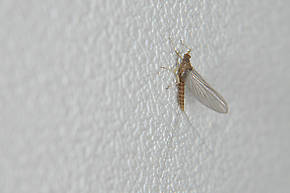 View 2 Pictures
View 2 Pictures
 View 2 Pictures
View 2 PicturesCollected June 30, 2011 from the Touchet River in Washington
Added to Troutnut.com by Bnewell on June 30, 2011
Added to Troutnut.com by Bnewell on June 30, 2011
Attenella margarita (Little Western Blue-Winged Olive) Mayfly Nymph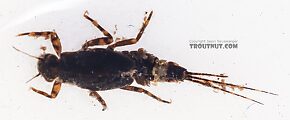 View 7 PicturesNotes from the microscope on the ID: Maxillary palp (
View 7 PicturesNotes from the microscope on the ID: Maxillary palp (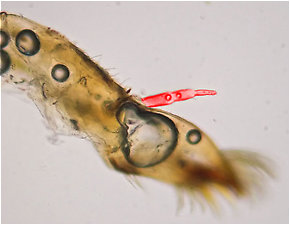 Palp: A long, thin, often segmented appendage which can protrude from certain insect mouth parts such as the maxillae. Also known as the < />palpus.) is present, distinctly 2-segmented, but very small. Gills on segment 4-7. This specimen has some unfortunate damage to the abdomen, but it's the only one I found in my sample.
Palp: A long, thin, often segmented appendage which can protrude from certain insect mouth parts such as the maxillae. Also known as the < />palpus.) is present, distinctly 2-segmented, but very small. Gills on segment 4-7. This specimen has some unfortunate damage to the abdomen, but it's the only one I found in my sample.
 View 7 PicturesNotes from the microscope on the ID: Maxillary palp (
View 7 PicturesNotes from the microscope on the ID: Maxillary palp (
The palp on the maxilla of an Ephemerella nymph (detached and photographed under a microscope) is highlighted in red here.
Collected August 3, 2020 from the East Fork Big Lost River in Idaho
Added to Troutnut.com by Troutnut on August 19, 2020
Added to Troutnut.com by Troutnut on August 19, 2020
Female Drunella flavilinea (Flav) Mayfly Dun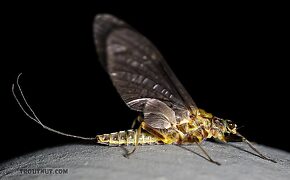 View 6 PicturesI can't be certain of the ID of this female dun, but I'm calling it Drunella flavilinea for three reasons: 1) the known abundance of "flavs" on the Henry's Fork, 2) clear differences in coloration from my confirmed specimens of Drunella coloradensis, which is the main lookalike, and 3) the habitat (a sizable river in a wide mountain valley, rather than a small, high-altitude stream) suggests it's not coloradensis.
View 6 PicturesI can't be certain of the ID of this female dun, but I'm calling it Drunella flavilinea for three reasons: 1) the known abundance of "flavs" on the Henry's Fork, 2) clear differences in coloration from my confirmed specimens of Drunella coloradensis, which is the main lookalike, and 3) the habitat (a sizable river in a wide mountain valley, rather than a small, high-altitude stream) suggests it's not coloradensis.
 View 6 PicturesI can't be certain of the ID of this female dun, but I'm calling it Drunella flavilinea for three reasons: 1) the known abundance of "flavs" on the Henry's Fork, 2) clear differences in coloration from my confirmed specimens of Drunella coloradensis, which is the main lookalike, and 3) the habitat (a sizable river in a wide mountain valley, rather than a small, high-altitude stream) suggests it's not coloradensis.
View 6 PicturesI can't be certain of the ID of this female dun, but I'm calling it Drunella flavilinea for three reasons: 1) the known abundance of "flavs" on the Henry's Fork, 2) clear differences in coloration from my confirmed specimens of Drunella coloradensis, which is the main lookalike, and 3) the habitat (a sizable river in a wide mountain valley, rather than a small, high-altitude stream) suggests it's not coloradensis.Collected July 31, 2020 from the Henry's Fork of the Snake River in Idaho
Added to Troutnut.com by Troutnut on August 16, 2020
Added to Troutnut.com by Troutnut on August 16, 2020
Male Tricorythodes (Tricos) Mayfly Spinner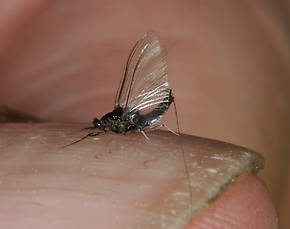 View 3 PicturesI collected these males about 9:30 AM, air temp. about 68 degrees F. The males were flying about 3 ft above the stream flying up and down the stream rather than the typical vertical swarm you see with most mayfly males. The males are black and the females are a green color due to the eggs they are carrying. They do not live very long which is typical for small bodied mayflies. They do not fly during windy conditions. I suspect these are Tricorythodes minutus.
View 3 PicturesI collected these males about 9:30 AM, air temp. about 68 degrees F. The males were flying about 3 ft above the stream flying up and down the stream rather than the typical vertical swarm you see with most mayfly males. The males are black and the females are a green color due to the eggs they are carrying. They do not live very long which is typical for small bodied mayflies. They do not fly during windy conditions. I suspect these are Tricorythodes minutus.
 View 3 PicturesI collected these males about 9:30 AM, air temp. about 68 degrees F. The males were flying about 3 ft above the stream flying up and down the stream rather than the typical vertical swarm you see with most mayfly males. The males are black and the females are a green color due to the eggs they are carrying. They do not live very long which is typical for small bodied mayflies. They do not fly during windy conditions. I suspect these are Tricorythodes minutus.
View 3 PicturesI collected these males about 9:30 AM, air temp. about 68 degrees F. The males were flying about 3 ft above the stream flying up and down the stream rather than the typical vertical swarm you see with most mayfly males. The males are black and the females are a green color due to the eggs they are carrying. They do not live very long which is typical for small bodied mayflies. They do not fly during windy conditions. I suspect these are Tricorythodes minutus.Collected August 12, 2011 from the Touchet River in Washington
Added to Troutnut.com by Bnewell on August 12, 2011
Added to Troutnut.com by Bnewell on August 12, 2011
Male Cinygmula mimus Mayfly Adult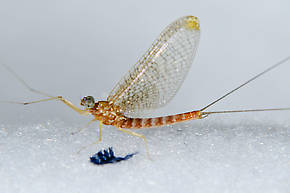 View 1 Pictures
View 1 Pictures
 View 1 Pictures
View 1 PicturesCollected May 20, 2012 from the Touchet River in Washington
Added to Troutnut.com by Bnewell on May 25, 2012
Added to Troutnut.com by Bnewell on May 25, 2012
Eurylophella (Chocolate Duns) Mayfly Nymph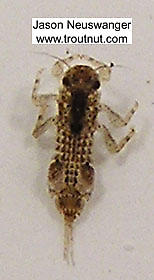 View 2 PicturesIt has the segment 4 gill and abdominal segment 9 is longer than segment 8. I couldn't see abdominal tubercles (
View 2 PicturesIt has the segment 4 gill and abdominal segment 9 is longer than segment 8. I couldn't see abdominal tubercles (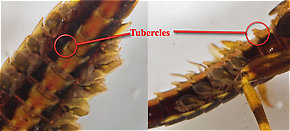 Tubercle: Various peculiar little bumps or projections on an insect. Their character is important for the identification of many kinds of insects, such as the nymphs of Ephemerellidae mayflies.), but they may not yet be developed in such an early instar (Instar: Many invertebrates molt through dozens of progressively larger and better-developed stages as they grow. Each of these stages is known as an instar. Hard-bodied nymphs typically molt through more instars than soft-bodied larvae.).
Tubercle: Various peculiar little bumps or projections on an insect. Their character is important for the identification of many kinds of insects, such as the nymphs of Ephemerellidae mayflies.), but they may not yet be developed in such an early instar (Instar: Many invertebrates molt through dozens of progressively larger and better-developed stages as they grow. Each of these stages is known as an instar. Hard-bodied nymphs typically molt through more instars than soft-bodied larvae.).
 View 2 PicturesIt has the segment 4 gill and abdominal segment 9 is longer than segment 8. I couldn't see abdominal tubercles (
View 2 PicturesIt has the segment 4 gill and abdominal segment 9 is longer than segment 8. I couldn't see abdominal tubercles (
A few (not all) of the abdominal tubercles on this Ephemerella needhami nymph are circled. They are especially large in this species.
Collected March 10, 2004 from unknown in Wisconsin
Added to Troutnut.com by Troutnut on January 19, 2006
Added to Troutnut.com by Troutnut on January 19, 2006
Female Epeorus albertae (Pink Lady) Mayfly Spinner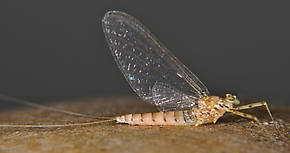 View 1 PicturesIt is hard to see where the name "Pink Lady" comes from.
View 1 PicturesIt is hard to see where the name "Pink Lady" comes from.
 View 1 PicturesIt is hard to see where the name "Pink Lady" comes from.
View 1 PicturesIt is hard to see where the name "Pink Lady" comes from.Collected June 29, 2011 from the Touchet River in Washington
Added to Troutnut.com by Bnewell on June 29, 2011
Added to Troutnut.com by Bnewell on June 29, 2011
Male Epeorus albertae (Pink Lady) Mayfly Spinner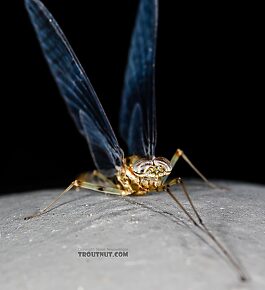 View 8 Pictures
View 8 Pictures
 View 8 Pictures
View 8 PicturesCollected August 1, 2020 from the Henry's Fork of the Snake River in Idaho
Added to Troutnut.com by Troutnut on August 18, 2020
Added to Troutnut.com by Troutnut on August 18, 2020
Female Paraleptophlebia bicornuta (Mahogany Dun) Mayfly Spinner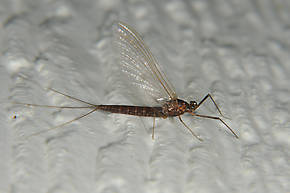 View 1 Pictures
View 1 Pictures
 View 1 Pictures
View 1 PicturesCollected October 3, 2011 from the Touchet River in Washington
Added to Troutnut.com by Bnewell on October 3, 2011
Added to Troutnut.com by Bnewell on October 3, 2011
Male Paraleptophlebia (Blue Quills and Mahogany Duns) Mayfly Dun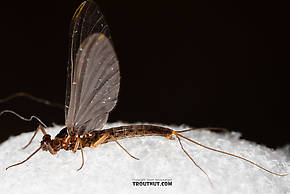 View 7 Pictures
View 7 Pictures
 View 7 Pictures
View 7 PicturesCollected August 11, 2018 from the Big Hole River in Montana
Added to Troutnut.com by Troutnut on June 11, 2019
Added to Troutnut.com by Troutnut on June 11, 2019
Top 10 Fly Hatches
Top Gift Shop Designs
Eat mayflies.
Top Insect Specimens
Miscellaneous Sites
Troutnut.com is copyright © 2004-2024 Jason
Neuswanger (email Jason). See my FAQ for information about use of my images.
 privacy policy
privacy policy
